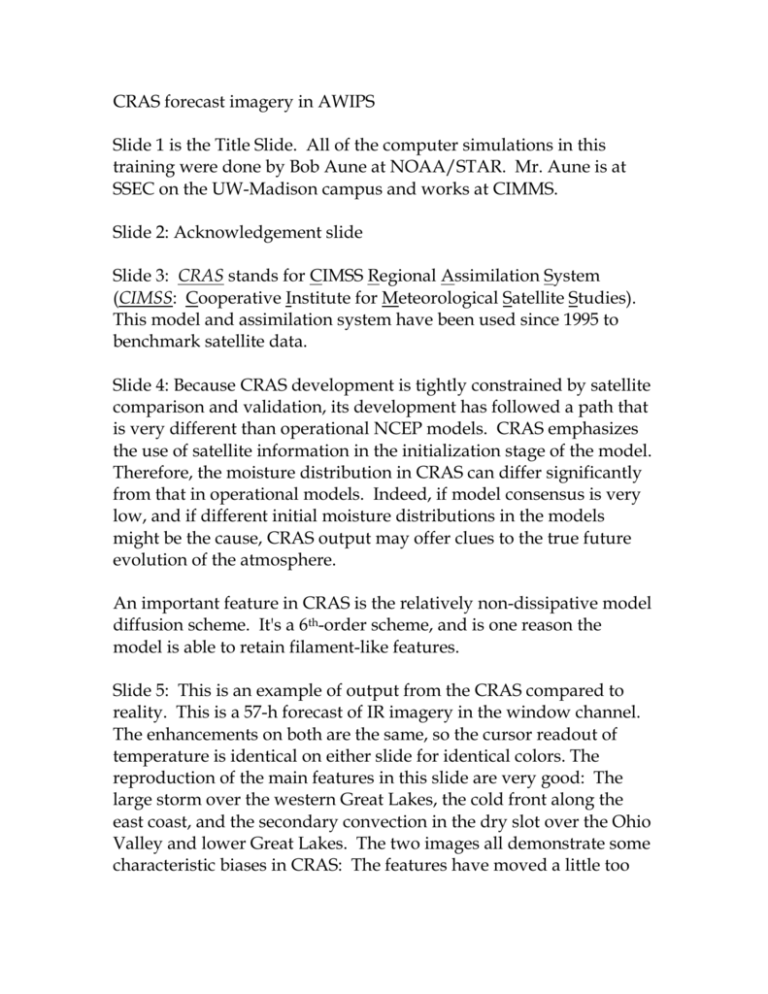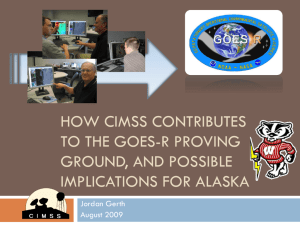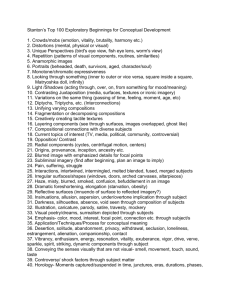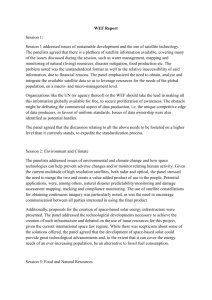CRAS forecast imagery in AWIPS
advertisement

CRAS forecast imagery in AWIPS Slide 1 is the Title Slide. All of the computer simulations in this training were done by Bob Aune at NOAA/STAR. Mr. Aune is at SSEC on the UW-Madison campus and works at CIMMS. Slide 2: Acknowledgement slide Slide 3: CRAS stands for CIMSS Regional Assimilation System (CIMSS: Cooperative Institute for Meteorological Satellite Studies). This model and assimilation system have been used since 1995 to benchmark satellite data. Slide 4: Because CRAS development is tightly constrained by satellite comparison and validation, its development has followed a path that is very different than operational NCEP models. CRAS emphasizes the use of satellite information in the initialization stage of the model. Therefore, the moisture distribution in CRAS can differ significantly from that in operational models. Indeed, if model consensus is very low, and if different initial moisture distributions in the models might be the cause, CRAS output may offer clues to the true future evolution of the atmosphere. An important feature in CRAS is the relatively non-dissipative model diffusion scheme. It's a 6th-order scheme, and is one reason the model is able to retain filament-like features. Slide 5: This is an example of output from the CRAS compared to reality. This is a 57-h forecast of IR imagery in the window channel. The enhancements on both are the same, so the cursor readout of temperature is identical on either slide for identical colors. The reproduction of the main features in this slide are very good: The large storm over the western Great Lakes, the cold front along the east coast, and the secondary convection in the dry slot over the Ohio Valley and lower Great Lakes. The two images all demonstrate some characteristic biases in CRAS: The features have moved a little too far in the model, and cirrus (high cloud) production in CRAS is underdone, especially in regions of heavy convection. Page 6: For completeness, the model equations. Note that moisture is represented by three separate equations: one for mixing ratio of water vapor, one for cloud water mixing ratio, and one for rain water mixing ratio. Page 7: CRAS improvements that have led to forecast imagery that is more representative of true imagery fall under three categories. Each are key. This training focuses on the latter two. Preservation of gradients is achieved via the very accurate 6th-order diffusion. Satellite data allow a more representative initialization of model moisture. Page 8 -- 10 : These give general CRAS characteristics. Note on page 10 the list of satellite moisture data, and other data, that are used in the CRAS initialization. The most important of these is the moisture data, but note that thermodynamic information in terms of thickness is also input Page 11: The CRAS model specifics relevant for the run that produces the forecast imagery for AWIPS. The data are on a 48-km grid; however, for AWIPS the data are interpolated onto a 4-km grid before the images are made. Output is every 3 hours from initial time through 72 hours. Page 12: Moisture information is input into the model by inserting satellite data 5 times into CRAS as it steps forward in time from (T12), where T is the initial time. By the time the model is at time T, the satellite information has significantly impacted especially the moisture fields, and to a far lesser extent the thermal and wind fields. Page 13: Previous mention has been made that forecast imagery looks very satellite-y, and this 12-h forecast of water vapor is an example. The long filaments of relatively warm or cold temperatures are characteristic of features seen in water vapor imagery. The smaller thumbnails at the bottom of the screen are 11 micron (window channel) imagery and data from a 20-km run. Can you easily tell the difference between the two? Page 14: An important reason behind the nice look of the WV imagery is the non-dissipative diffusion filter that is used in CRAS. The filter is 6th-order, and as this slide shows, it more nearly represents perturbations than the more dissipative 2nd-order diffusion that is common in other numerical simulations. This filter leads to more accurate simulations of clouds in the model, and more accurate clouds mean a more accurate model. Page 15: Different satellite data are used differently in the model. Cloud top pressure and Effective Cloud Amount (CTP and ECA) are used to remove clouds from the initial fields of the model that aren't present in reality, or to insert clouds that are missing from the initial fields. Page 16: This slide shows the character of precipitable water distribution in the CRAS model. The small-scale features in the model have an echo in the GOES observations. Page 17: Here we show the evolution from the initial first guess field (bottom left) to the final initial analysis (upper right). Observations are shown in the bottom right. Note the subtle variations in the precipitable water analysis that are introduced into the initial field. Of course, there are no observations in the central Plains, where a storm is developing, due to clouds, but the better defined distribution in the region over the southern Plains that will advect into the central and northern Plains should have a positive impact on the forecast. Page 18: How are the forecast images made? In the case of the window channel, a vertical integration upwards is performed. Skintemperature emits radiance that is transmitted upwards in the model. If the cloud mass gets past a threshold value, however, the brightness temperature is reset to the cloud-top temperature, and the upwardsintegrated transmissivity is recomputed. The water vapor images are computed using GOESTRAN, a 101-level radiative transfer model that uses model temperature and mixing ratios. This computation is performed in clear air only (You'll note the absence of clouds in the forecast 6.7- imagery compared to observations) Page 19: Forecast imagery have been fed into AWIPS via the Central Region ldad for some months now, and several AFDs have commented on its simple presentation that allows easy digestion of model output. Page 20: How does CRAS data get to AWIPS? Output grids are converted to images, and remapped into the AWIPS projection. These netCDF files are then injected into ldm, and the ldad at the Central Region ingests the imagery and pushes it to offices that request it. Page 21: Where is CRAS data on the AWIPS menu? It's part of the satellite pull-down. There are three different choices: An east projection, that ends at about 105 W (near Denver), a west projection that starts at about 95 W (near Minneapolis/St. Paul), and a combined projection that extends across CONUS. All three include IR imagery (in the window channel) and WV imagery (at 6.7 ) Page 22: Note that the water vapor imagery has a noticeable seem near 105 W. This is where the GOESTRAN forward radiative transfer model that simulates the 6.7 radiance switches from GOES-12 transmittance coefficients to GOES-11 transmittance coefficients. Recall that CRAS output are used to test satellite output, so it is sensible to compute the radiances at 6.7 with the appropriate satellite transmittance values. The loop shows the development of a strong system on the east coast, including the apparent development of a cold conveyor belt over the central Appalachians in West Virginia. Page 23: Observations show the development of this same system, as observed in the water vapor channel. A comparison of the two loops will reveal the moist bias in CRAS -- CRAS does not see as far down into the atmosphere as the satellite does; consequently, the amount of yellow in the images is greater in observations than in simulations. Page 24: This 72-h forecast imagery loop shows the development and phasing of a strong storm over the western Great Lakes. As with water vapor, the enhancement curves on the CRAS data are the same as observed, so similar colors in CRAS input show the same temperature (as, for example, when the cursor readout is used) as the same color in observed data. Page 25: Here's a fader between a 51-h prediction and observations. CRAS does a fair job of reproducing large-scale aspects of this feature: The cold front along the east coast, dry-slot convection in the middle Ohio Valley and lower Great Lakes, and the storm center over the upper Great Lakes. There are modest timing issues in the 51-h forecast that suggest the CRAS may be too fast. Given that the smoothing does not reduce gradients -- and hence the geostophic wind, for example, may be stronger -- the fast translation of systems is not unexpected. Page 26: A list of references for further reading on the CRAS Page 27: If you have questions, contact Bob Aune at the email given. More complete model output is available at the website given. This website includes MSLP, heights and temperatures at standard pressures and precipitation.








